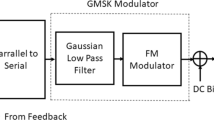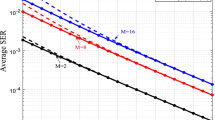Abstract
In this paper, we consider a free-space optical communication system using subcarrier intensity modulation (SIM) with general-order rectangular quadrature amplitude modulation (QAM) and operating over Gamma–Gamma turbulence channels subjected to pointing errors. We derive novel, exact closed-form expression for the average symbol error probability of the considered system in terms of the Fox H function. Using the derived analytical results, we investigate the combined effects of turbulence-induced fading and misalignment-induced fading on the performance of the SIM-QAM FOS communication system. Numerical and computer simulation results are presented in order to verify the accuracy of the proposed mathematical analysis.



Similar content being viewed by others
Notes
Our results indicate excellent agreement for higher order QAM modulations, but are excluded due to space constraints.
References
Ghassemlooy, Z., Popoola, W., & Rajbhandari, S. (2013). Optical wireless communications. System and channel modelling with MATLAB. Boca Raton, FL: CRC Press, Taylor & Francis Group.
Li, E. J., Liu, J. Q., & Taylor, D. P. (2007). Optical communication using subcarrier PSK intensity modulation through atmospheric turbulence channels. IEEE Transactions on Communications, 55(8), 1598–1606.
Popoola, W. O., Ghassemlooy, Z., Allen, J. I. H., Leitgeb, E., & Gao, S. (2008). Free-space optical communication employing subcarrier modulation and spatial diversity in atmospheric turbulence channel. IET Opto Electronics, 2(1), 16–23.
Popoola, W. O., & Ghassemlooy, Z. (2009). BPSK subcarrier modulated free-space optical communications in atmospheric turbulence. Journal of Lightwave Technology, 27(8), 967–973.
Samimi, H., & Azmi, P. (2010). Subcarrier ıntensity modulated free-space optical communications in K-distributed turbulence channels. Journal of Optical Communications and Networking, 2(8), 625–632.
Samimi, H. (2012). Optical communication using subcarrier intensity modulation through generalized turbulence channels. IEEE/OSA Journal of Optical Communications and Networking, 4(5), 378–381.
Peppas, K. P., & Datsikas, C. K. (2010). Average symbol error probability of general-order rectangular quadrature amplitude modulation of optical wireless communication systems over atmospheric turbulence channels. IEEE/OSA Journal of Optical Communications and Networking, 2, 102–110.
Zoheb Hassan, Md, Song, X., & Cheng, J. (2012). Subcarrier ıntensity modulated wireless optical communications with rectangular QAM. Journal of Optical Communications and Networking, 4(6), 522–532.
Farid, A. A., & Hranilovic, S. (2007). Outage capacity optimization for free-space optical links with pointing errors. Journal of Lightwave Technology, 25(7), 1702–1710.
Song, X., Yang, F., & Cheng, J. (2013). Subcarrier ıntensity modulated optical wireless communications in atmospheric turbulence with pointing errors. IEEE/OSA Journal of Optical Communications and Networking, 5(4), 349–357.
Kilbas, A., & Saigo, M. (2004). H-transforms: Theory and applications (Analytical method and special function) (1st ed.). Boca Raton: CRC Press.
Zhu, X., & Kahn, J. M. (2002). Free-space optical communication through atmospheric turbulence channels. IEEE Transactions on Communications, 50(8), 1293–1300.
Gradshteyn, I. S., & Ryzhik, I. M. (2000). Table of integrals, series, and products (6th ed.). New York: Academic.
I. Wolfram Research. (2010). Mathematica edition: Version 8.0. Champaign, IL: Wolfram Research Inc.
Sandalidis, H. G., Tsiftsis, T. A., & Karagiannidis, G. K. (2009). Optical wireless communications with heterodyne detection over turbulence channels with pointing errors. Journal of Lightwave Technology, 27(20), 4440–4445.
Mittal, P., & Gupta, K. (1972). An integral involving generalized function of two variables (pp. 117–123). Bengaluru: Indian Academy of Sciences.
Peppas, K. (2012). A new formula for the average bit error probability of dual-hop amplify-and-forward relaying systems over generalized shadowed fading channels. IEEE Wireless Communications Letters, 1(2), 85–88.
Yi, X., Liu, Z., & Yue, P. (2013). Formula for the average bit error rate of free-space optical systems with dual-branch equal-gain combining over gamma–gamma turbulence channels. Optics Letters, 38(2), 208–210.
Yilmaz, F., & Alouini, M.-S. (2009). Product of the powers of generalized Nakagami-m variates and performance of cascaded fading channels. In Proceedings of IEEE global communications conference (GLOBECOM 2009), Honolulu, Hawaii, USA, November 30–December 4.
Author information
Authors and Affiliations
Corresponding author
Appendices
Appendix 1: Derivation of Closed-Form Solution for \({\mathcal{M}}\left( {\alpha ,\beta ,\bar{\mu },\xi } \right)\)
In this Appendix, we present the derivation of an exact closed-for expression for the integral \({\mathcal{M}}\left( {\alpha ,\beta ,\bar{\mu },\xi } \right) = \mathop \int \limits_{0}^{\infty } Q\left( {\xi \sqrt \mu } \right)f_{\mu } \left( \mu \right)d\mu\). First note that we can write Gaussian Q function in terms of the complementary error function \({\text{erfc}}\left( \cdot \right)\) as Q \(\left( x \right) = 1/2{\text{erfc}}\left( {x/\sqrt 2 } \right)\) Furthermore, the erfc(.) function can be written in terms of the Meijer G function as \({\text{erfc}}\left( z \right) = 1/\sqrt {\pi } G_{1, 2}^{2, 0} \left( {\left. {z^{2} } \right|_{1/2 , 0}^{ 1} } \right)\) [13]. Finally, using [13, Eq. (6.2.8)], we can write the Meijer G function in terms of the desired Fox H function yielding
Using (8) and (3), \({\mathcal{M}}\left( {\alpha ,\beta ,\bar{\mu },\xi } \right)\) can be described as
Using the integral identity [13, Eq. (2.8.4)], \({\mathcal{M}}\left( {\alpha ,\beta ,\bar{\mu },\xi } \right)\) can be derived in closed-form as
Appendix 2: Derivation of Closed-Form Solution for \({\mathcal{F}}\left( {\alpha ,\beta ,\bar{\mu },\xi ,\rho } \right)\)
In this Appendix, we present the derivation of an exact closed-for expression for the integral\({\mathcal{F}}\left( {\alpha ,\beta ,\bar{\mu },\xi ,\rho } \right) = \mathop \int \limits_{0}^{\infty } Q\left( {\xi \sqrt \mu } \right)Q\left( {\rho \sqrt \mu } \right)f_{\mu } \left( \mu \right)d\mu\). Using (8) and (3),\({\mathcal{F}}\left( {\alpha ,\beta ,\bar{\mu },\xi ,\rho } \right)\) can be written as
Using the identity [16, Eq. (2.3)], \({\mathcal{F}}\left( {\alpha ,\beta ,\bar{\mu },A_{I} ,A_{Q} } \right)\) can be obtained in terms of the bivariate Fox H function as
Rights and permissions
About this article
Cite this article
Samimi, H. Performance of Subcarrier Intensity Modulated FSO Systems over Gamma–Gamma Turbulence Channels with Pointing Errors. Wireless Pers Commun 95, 1407–1416 (2017). https://doi.org/10.1007/s11277-016-3854-z
Published:
Issue Date:
DOI: https://doi.org/10.1007/s11277-016-3854-z




